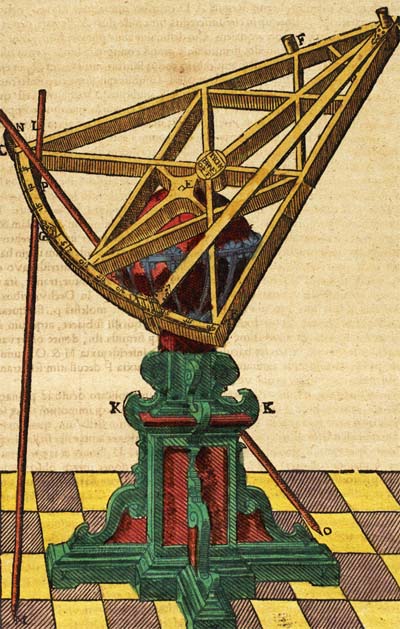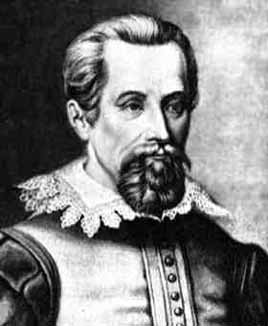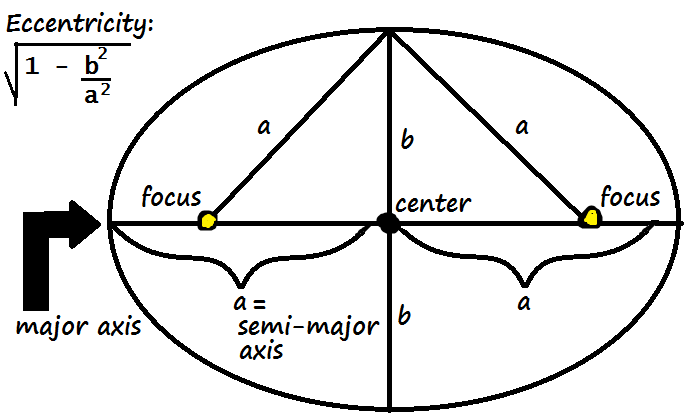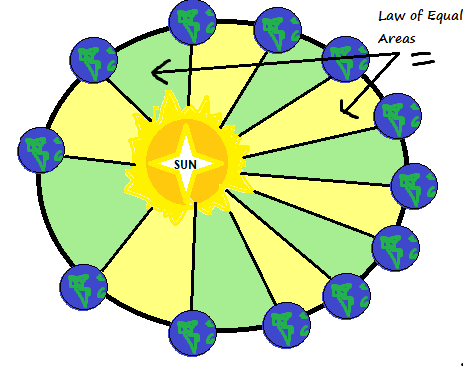Chapter 1: Early Astronomy
by Saree Costa, Mario Jaramillo and Christina Kogat
Tycho Brahe
(1546 - 1601)
A Danish nobleman well known as being a great astronomer and alchemist. Tycho Brahe is
known as one of the last well-known astronomers who worked without telescopes for his
observations. Even without the use of telescopes, Brahe is recognized with some of the
 most accurate astronomical observations of his time and even reformed observation practices greatly.
most accurate astronomical observations of his time and even reformed observation practices greatly.
He was born in what was Skane, Denmark (now Sweden) on December 14, 1546 to a noble
family. His parents were Otto Brahe and Beate Bille, but he was raised a scholar by his
uncle Jørgen Thygesen Brahe. It is said that when Tycho was young his uncle took him
without the knowledge of his parents to make him a scholar. He first started studying
Law, but he became interested in astronomy in 1560. The solar eclipse in August of 1560 impressed
him, and what really got him studying astronomy was the fact that the eclipse
had been predicted. A few years later, at the age of 17, Tycho saw that none of the charts of the
planets and stars matched each other and came to the conclusion that in order for progress to occur
in astronomy a systematic and rigorous observation was needed
over the course of years. This is one way that he changed observation practices, the other was
in his constant innovations and improvement of new and existing instruments.
Even though Tycho is distinguished by his career in astronomy, he is always very well known
for his nose. He lost part of his nose while studying at the University of Rostock. He was in a
duel with a Danish nobleman over a mathematical quarrel and it resulted
in Tycho losing the front portion of his nose. It is said that he wore noses of different
materials which included copper, silver and gold.
During his distinguished career, Brahe made notable accomplishments with his instruments.
Since it is necessary to have the greatest possibly accuracy with angles to correctly measure
the positions and motions of celestial planets, Tycho needed to create
a more advanced, accurate instrument that he could also calibrate and check for accuracy in
order to ensure reliable observations. Based upon older drawings, Tycho built his first
instrument in 1564 which was only accurate to one degree, far too imprecise
for the needed measurements, so he was able to create a device to be accurate within 1/120 of a degree.
Brahe's measurements and instruments


With his new instruments, Tycho was able to accurately measure the positions and motions of
stars, planets, and comets and could tell that the stars were much further away than the planets,
a new idea for the time, and calculated the star's positions. In
addition, he was able to measure the positions and motions of planets and deduce that celestial
bodies were not attached to any spheres but moved in empty space.
These observations directly conflicted with the theories of Aristotle and Ptolemy in
which the Moon, Sun, and planets perfectly circle the Earth. Thus, Tycho was able to combine the
geometric benefits of the Copernican system of a changing celestial realm
with the philosophical benefits of the Ptolemaic system to create the Tychonic system.
Years after his death in 1601, Tycho's astronomical observations on the motion of Mars provided
measurements to enable the development of the laws of planetary motion and the concept of elliptical
orbits published by his assistant, Johannes Kepler.
Johannes Kepler
(1571 - 1630)
Johannes Kepler was born prematurely on December 27, 1571 in Free Imperial City of Weil der Stadt,
modern-day Stuttgart Region of Baden-Wurttemberg, Germany. He was the son of Katharina Guldenmann,
who was an herbalist and a healer later tried for witchcraft.
When Johannes Kepler was five, his mercenary father left his family, consisting of two other
brothers and one sister. Due to his premature birth, he was a constantly ill child. Regardless,
 his mathematical abilities were sure to impress everyone.
his mathematical abilities were sure to impress everyone.
After Kepler witnessed the Great Comet of 1577, at the ripe age of six, his interest in
astronomy would only grow.
Johannes Kepler became a brilliant mathematician who worked with Brahe's data for 30 years. His
first task was to figure out earth's orbit. While he waited one Mars year, he noticed Earth moved,
then subsequently determined Mars' orbit. Matching data with
circles did not work to fit Earth's and Mars' orbits. If circles were used for Earth's and Mars'
orbit, the data was off by 8/60 of a degree. Thus, Kepler found himself at the brink of his
first law of planetary motion, The Law of Elipses. While everyone thought
the planets moved in a circular path, Kepler proposed a different idea--that the planets moved
about in an elliptical orbit and presented his data.
Elipses
An ellipse is a stretched out circle. The shape of an ellipsis is defined by the eccentricity, e.
A circle has an eccentricity of 0. The larger the value of e, the more oval the ellipse is.
The earth has an eccentiricty that is fairly close to a circle, 0.0167.

Kepler's Laws
- The Law of Ellipses: The planets move in elliptical paths around the sun, with the sun
at one of the focal points.
- The Law of Equal Areas: The imaginary line drawn from the sun to a planet sweeps out an
equal area of space in equal amounts of time.
Each of the green and yellow triangular slivers below should be equal in size.

- The Law of Harmonies: T2 ~ a3, where Period (T) is the time
for 1 orbit around the sun, and (a) is the semi-major axis.
The ratio of the squares of the periods, T, of any two planets is equal to the ratio of the
cubes of their semi-major axis, or, their average distances from the sun.
This was the first quantatative analysis of a planet around the sun.
Perihelion: The perihelion is the point at which a planet's orbit is closest to
the sun and moves the fastest.
Aphelion: The aphelion is the point at which a planet's orbit is the farthest from the sun.

| Type of Body |
Body |
Distance from Sun at Perihelion |
Distance from Sun at aphelion |
| Planets |
Mercury |
46,001,009 km
(28,583,702 mi) |
69,817,445 km
(43,382,549 mi) |
| Venus |
107,476,170 km
(66,782,600 mi) |
108,942,780 km
(67,693,910 mi) |
| Earth |
147,098,291 km
(91,402,640 mi) |
152,098,233 km
(94,509,460 mi) |
| Mars |
206,655,215 km
(128,409,597 mi) |
249,232,432 km
(154,865,853 mi) |
| Jupiter |
740,679,835 km
(460,237,112 mi) |
816,001,807 km
(507,040,016 mi) |
| Saturn |
1,349,823,615 km
(838,741,509 mi) |
1,503,509,229 km
(934,237,322 mi) |
| Uranus |
2,734,998,229 km
(1.699449110×109 mi) |
3,006,318,143 km
(1.868039489×109 mi) |
| Neptune |
4,459,753,056 km
(2.771162073×109 mi) |
4,537,039,826 km
(2.819185846×109 mi) |
| Dwarf Planets |
Ceres |
380,951,528 km
(236,712,305 mi) |
446,428,973 km
(277,398,103 mi) |
| Pluto |
4,436,756,954 km
(2.756872958×109 mi) |
7,376,124,302 km
(4.583311152×109 mi) |
| Makemake |
5,671,928,586 km
(3.524373028×109 mi) |
7,894,762,625 km
(4.905578065×109 mi) |
| Haumea |
5,157,623,774 km
(3.204798834×109 mi) |
7,706,399,149 km
(4.788534427×109 mi) |
| Eris |
5,765,732,799 km
(3.582660263×109 mi) |
14,594,512,904 km
(9.068609883×109 mi) |
Line of Solstice, Equinoxes
Earth experiences a solstice twice a year, when the Sun is highest in the sky from the
North or South Pole. The Line of Solstice is an imaginary line, which is the projection of
the Earth's axis on its orbital plane. An equinox occurs twice a year as well,
when the center of the Sun is in the same plane as the Earth's equator, and the Earth's is
inclined neither towards nor away from the Sun.

Precession of the Axis: Precession of the axis is the movement of the rotational
axis of the earth, or other astronomical body whereby the axis gradually traces a cone. It takes
our Earth approximately 26,000 years to complete a full precessional
cycle.
Nicolaus Copernicus
Nicolaus Copernicus was born on February 19, 1473 in Poland. His father was a merchant and his
mother was the daughter of a wealthy merchant. He was the youngest of four children and never married
 or had children but did take care of his sister’s five children
up until his death.
or had children but did take care of his sister’s five children
up until his death.
Copernicus was able to speak Latin, German, Polish, Greek, and Italian.
Copernicus’ uncle had connections to schools in Poland and was able to make sure that Copernicus
was able to attend St. John’s School, the Cathedral School and then the University of Krakow. His
studies at the University gave him grounding in math and astronomy
and also developed his critical analysis to Aristotle’s theory of homocentric spheres and Ptolemy’s
mechanism of eccentrics and epicycles, which were the two most popular systems of astronomy at the time.
Upon leaving the University of Krakow, Copernicus left for his uncle’s court but was then sent to
study law at the Bologna University in Italy. While studying, he spent less time on law and ended
up focusing more on astronomy observing a lunar eclipse in
1500. After three years at Bologna, Copernicus once again relocated to the University of Padua to
study medicine but again ended up focusing on astronomy. It was at Padua that his Hellenistic interests
began and where he solidified his idea that the Earth
moved around the Sun.
After receiving his degree of doctor of canon law, Copernicus became his uncle’s secretary and
physician from 1503 to his uncle’s death in 1512. During this time he also began to work on his
heliocentric theory. By 1514, Copernicus had written an initial
outline of his heliocentric theory describing the world’s heliocentric mechanism. From 1512-1515,
he observed Mars and Saturn and in 1515 his series of four observations of the sun led to his
discovery of the variability of Earth’s eccentricity and of the
movement of the solar apogee in relation to fixed stars.
By 1532, Copernicus had finished his manuscript De Revolutionibus Orbium Coelestium but was urged
by several friends not to publish his work so that he would not have to face public scorn for his
views. His book was published right before his death in 1543
with an advance copy given to him the day he died.
Copernicus's Solar System
Copernicus presented a model of the Solar System where the Sun was the center instead of the
Earth. This is also known as a heliocentric model. With this system, we derive our current ordering
of the planets. Published in 1543, Copernicus' model was quite
a leap from the Ptolemaic model, which placed the Earth at the cent of the Universe.
Galileo Galilei
Galileo Galilei (1564-1642) was an Italian physicist, mathematician, philosopher, and astronomer.
During his time, while most people accepted geocentrism or the Tychonic system, Galileo believed in
heliocentrism going against both astronomers and the church.
Galileo was born in Pisa, Italy and was the first of six children. His father was an accomplished
composer and lutenist and taught Galileo to play as well where he learned to be skeptical of
authority, use quantified experiments and respect rhythm. During
his young adulthood, his family ran into financial problem, which might have fostered Galileo’s early
 drive to develop inventions as a means of additional income. Though a devout Roman Catholic, Galileo
fathered three illegitimate children with Marina Gamba.
drive to develop inventions as a means of additional income. Though a devout Roman Catholic, Galileo
fathered three illegitimate children with Marina Gamba.
At first, he seriously considered becoming a priest, however due to his father’s urging enrolled in
medical school. While there, he accidentally walked into a geometry class and persuaded his father to
let him study math and science instead. While in school
he noticed a chandelier swinging and realized that the chandelier too the same amount of time to
swing back and forth no matter how far it was swinging. He then used pendulums to demonstrate the
same idea, however it was another hundred years before this was
used to keep time. In school, Galileo also studied the fine arts and in 1588 became an instructor at
the Accademia delle Arti del Disegno. In 1589, he was appointed to the chair of mathematics in Pisa but
after his father’s death in 1591 needed to look after
his younger brother and moved to the University of Padua teaching geometry, mechanics, and astronomy
until 1610. During his time teaching at the University of Padua, Galileo made significant discoveries
in both applied and fundamental science such as improving
the telescope and the kinematics of motion and astronomy.
One of the first theories Galileo used to defend the Copernican system was based off of the
tides. Galileo said that the water moving back and forth in the sea as the Earth sped up and slowed
down while rotating around the sun caused the tides. This theory
was incorrect though and Galileo knew that because there were two tides a day in Venice while his
theory provided only one, but dismissed this anomaly due to other causes. In his book Dialogue
Concerning the Two Chief World Systems, commissioned by Pope Urban
VIII, Galileo was supposed to give arguments for and against heliocentrism but not to advocate it.
However, his book came off as advocating the Copernican system and resulted in him being tried during
the Inquisition in 1633 and convicted of heresy and placed
under house arrest for the rest of his life.
His contributions to science include improvements to the telescope, which lead to further
astronomical observations such as the phases of Venus, Jupiter’s four largest moons and sunspots.
Along with these observations, he improved the military compass among
other instruments.
| Mercury |
.206 |
| Venus |
.0068 |
| Earth |
.0167 |
| Mars |
.0934 |
| Jupiter |
.0485 |
| Saturn |
.0556 |
| Uranus |
.0472 |
| Neptune |
.0086 |
| Pluto |
.25 |
|
Planet
|
Semimajor
axis
(1010m)
|
Period
T (y)
|
T2/a3
(10-34y2/m3)
|
| Mercury |
5.79 |
0.241 |
2.99 |
| Venus |
10.8 |
0.615 |
3.00 |
| Earth |
15.0 |
1 |
2.96 |
| Mars |
22.8 |
1.88 |
2.98 |
| Jupiter |
77.8 |
11.9 |
3.01 |
| Saturn |
143 |
29.5 |
2.98 |
| Uranus |
287 |
84 |
2.98 |
| Neptune |
450 |
165 |
2.99 |
| Pluto |
590 |
248 |
2.99 |
 his mathematical abilities were sure to impress everyone.
his mathematical abilities were sure to impress everyone. most accurate astronomical observations of his time and even reformed observation practices greatly.
most accurate astronomical observations of his time and even reformed observation practices greatly.






 or had children but did take care of his sister’s five children
up until his death.
or had children but did take care of his sister’s five children
up until his death. drive to develop inventions as a means of additional income. Though a devout Roman Catholic, Galileo
fathered three illegitimate children with Marina Gamba.
drive to develop inventions as a means of additional income. Though a devout Roman Catholic, Galileo
fathered three illegitimate children with Marina Gamba.